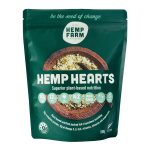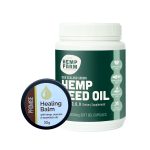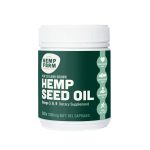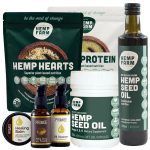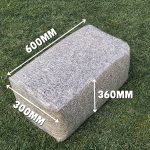Hemp Environmental Benefits
Remarkable Ways Hemp Can Save the Planet
Not only can hemp help preserve our planet and improve our manufacturing, it can help fuel us forward and decrease our dependence on fossil fuels. With the capability to produce vital resources such as rope, clothing, and paper, the hemp plant has played a crucial role throughout our history. Archeological evidence suggests that we’ve been using hemp since as early as 8,000 B.C., making it the first plant ever cultivated.
Alternative to Plastic
Every piece of plastic that has ever been made still exists in the world today. Plastic typically takes between 500 and 1,000 years to decompose in a landfill – water bottles take 450 years, fishing nets 600 years, and bags about 20 years. All of these products could end up in the ocean, harming marine life, and even our lives. Sahera Kaplan once stated that by 2050 there would be more plastic in the ocean than fish.
But, there is hope. Instead of using these plastic products that are destroying our planet, we could use hemp plastic products. Hemp is the greatest cellulose producer on earth, and it’s biodegradable. Hemp can form part of a biocomposite plastic whereby it’s either part of a totally organic mix or is mixed with a synthetic polymer. Studies have found hemp-based plastics to be 2.5 times stronger and five times stiffer than traditional plastic that is made from polypropylene.
It’s no surprise then that close to 100 years after Henry Ford made his first hemp car, many companies in the automobile industry are making use of hemp plastic. This car, made of hemp, was lighter than steel but could withstand ten times the impact without denting – impressive, right? Other products being made of hemp plastic include sunglasses, dog toys, and plastic bags.
Hemp – An Alternative to Plastic.
Prevent Deforestation
Hemp could potentially replace pretty much anything that is made from timber. Hemp is an incredibly valuable natural resource that is very underutilized. As one of the strongest fibres on the planet, using hemp for construction purposes will result in lighter and stronger wood products. Hemp is also able to hold nails better, and particle boards that are made of hemp are typically twice as strong as wood. Furthermore, just 1 acre of hemp will produce cellulose fibre pulp that is equal to 4 acres of trees, which means that hemp could quite easily and efficiently replace the majority of items that are made of wood.
Historically speaking, hemp was used to create many different products. In fact, the word “canvas” was derived from a Dutch word that means cannabis, which effectively means that real canvas was derived from hemp. Thousands of years ago, this magic plant was used to make all different kinds of commercial products such as textiles, rope, canvas, and paper.
There is a lot of potential for using hemp to prevent deforestation, promote sustainability, and save the lives of animals, and humans. The use of hemp gives us the opportunity to save natural resources, ensuring that we leave something behind for future generations. While it takes only around four months for hemp to be ready for commercial harvest, it takes trees between 20 to 50 years. Deforestation is increasing globally at a frightening rate. Researchers believe that the rate of deforestation is equal to the loss of 48 football fields every minute. It’s estimated that within a hundred years there will be no rainforests. This is one of the reasons that hemp is so valuable – it can replace trees as a source of raw material for paper and wood.
Hemp Can Feed The World
The healthy and sustainable protein that could help feed the world
There are around 795 million people globally that are undernourished. In developing countries, 30 out of every 100 children will experience stunted growth because of lack of nutrition. But hemp could change all of this. Not only is it inexpensive, but it can be grown just about anywhere. Believe it or not, hemp seeds are thought to be the most nutritionally dense food source on the planet. Hemp seeds are a complete protein and provide the body with vitamins, amino acids, and much more.
Hemp seeds can produce two of our most vital food products – flour and oil. Hemp protein powder is an excellent source of complete protein which naturally contains all the essential amino acids required by the human body. Hemp seeds provide the body with all three Omegas: Omega-3, -6 and -9, plus various vitamins and minerals, including the B group, calcium, iron, and zinc. Three tablespoons of hemp protein powder contain around 90 calories and 3 grams of fat while providing 15 grams of protein. It’s easier to digest than soy and can be milled into flour for baking, or for adding to smoothies, or made into hemp milk as a nutritious dairy alternative.
It’s critical, now more than ever that we pursue more sustainable sources of protein to feed the planet. And while there are many new and exciting alternatives, let’s not forget that Hemp has been one of humanity’s most essential agricultural commodities for thousands of years.
We believe that hemp’s time has come again. So let’s all get on board and be part of the movement. Learn more about how hemp can help feed the world
Hemp Building Materials
Although it seems unlikely that entire houses can be built from hemp, it has become a reality thanks to hempcrete, which is a more sustainable alternative to concrete. Made from water, lime, and – of course – hemp, hempcrete has a negative carbon footprint, which means that more CO2 is absorbed by the hemp plant during cultivation that would be emitted during construction. Even more impressive, walls that are made of hempcrete will continue to absorb carbon dioxide throughout their lifetime. Essentially, this is a building material that just keeps giving back to the environment.
The same fibres that can be used to produce plastic can also produce a variety of eco-friendly alternatives that will help preserve the world’s natural resources:
- Hempcrete is a natural material made using hemp shivs and lime that can replace concrete, drywall, and insulation. It is 7 times lighter so it’s easier to work with, and provides more efficient insulation, thermal regulation, and fire resistance compared to concrete.
- Hemp can be used to produce a steel alternative that is 10 times stronger than steel and 6 times more efficient at mending and bending than steel. The use of hemp steel will also reduce the negative impacts of steel production such as harmful emissions into the air and water, waste, and energy usage.
- The fibres in hemp can be used to replace wood in most applications, and can produce products such as flooring, roofing, insulation, and many other building materials.
Prevents Pesticide Pollution
Unlike flax or cotton – which have been estimated to consume 50% of all pesticides – hemp is naturally resistant to pests. This means that growing hemp doesn’t require any herbicides or pesticides.
When pesticides are sprayed onto the land, they can easily make their way into water sources such as oceans, rivers, or ponds. If pesticides contaminate the water, they could easily harm the living creatures in that water or anyone who ingests it. Even scarier, pesticides have been linked to birth defects, ADHD, and Alzheimer’s, to name a few diseases. So pesticides aren’t only dangerous to the environment, but are also hazardous to our health.
Soil Decontamination
One of the most impressive qualities of hemp is that it clean up pollution. So while our modern industries pollute, hemp has the opposite effect. Hemp has the potential to remove radioactive toxins and heavy metals from polluted soil. This is done through a process known as phytoremediation, whereby contaminants are absorbed through the fast-growing roots of the hemp plant that stores or sometimes even transforms toxins into other harmless substances.
An Italian study that was published in Plant and Soil in 2003 found that hemp had the ability to absorb nickel, chromium, and cadmium from soil, and also that high concentrations of the heavy metals had a very little effect on plant morphology. Hemp can grow in a variety of soil types and terrains. It forms deep roots which help to hold the soil together, which also helps to prevent soil erosion.
Hemp also increases the microbial contents of the soil, and its leaves and stems are rich in nutrients. After harvesting has taken place, these can be returned to the soil which will rejuvenate it for a richer yield the following year.
It’s time that hemp regained its place as of the most sustainable and versatile crops on the planet. As Jack Herer is famously quoted, “I’m not sure that hemp will save the planet… but I know it’s the only thing that can.” It’s time we let the hemp revolution take place if we really want to change the world that we currently live in.
Hemp Can Save the Earth from Pollution
Hemp Soil Remediation and the Chernobyl Disaster
Beyond the hemp fields
Hemp’s replacement for plastic is already making some serious inroads, particularly in the automotive industry. Luxury car makers such as Polestar, BMW and Porsche have all utilised hemp composites to lighten the load of their cars. Hemp plastics are a godsend for car manufacturers, thanks to their weight and strength, being 3.5 times stronger than oil-based plastics and 5 times lighter all while remaining biodegradable.
It’s not only the production of cars where hemp can help us get from A to B with less impact on the planet. The plant can also be processed into bio-fuel, and used in any diesel engine without modification. By using a crop that sequesters the CO2 it produces through combustion, hemp has the potential to at least stabilise carbon levels in the atmosphere while greener alternatives are found.

Eco-Friendly & Sustainable-Fuel
Not only can hemp help preserve our planet and improve our manufacturing, it can help fuel us forward and decrease our dependence on fossil fuels.
Although the hemp plants that were grown near the Chernobyl area cannot be made into medicine or food, these plants can be safely distilled to become ethanol and used as biofuel.
For instance, Belarus has conducted several experiments in growing hemp at contaminated soil to be used as fuel later on. By using hemp in creating biofuels such as ethanol, scientists believe that they will be able to take advantage of the hemp’s ability to remove contaminants from the soil. When growing hemp, the contaminants are removed from the soil and are trapped in the plants. Once the crop cycle is completed, the contaminants are entirely removed from the soil.
According to the National Hemp Association, hemp can be used to produce two types of fuels:
- Biodiesel — produced from the oil of the pressed hemp seed
- Ethanol/Methanol — produced from the fermented hemp stalk.
With the increasing problems surrounding traditional fossil fuels and oils, the need for a natural alternative is stronger than ever.
Hemp is the only alternative fuel that can run in any unmodified diesel engine, and provides a solution that is more efficient, more affordable, and most importantly, more sustainable than traditional fuel.
References
- https://www.marijuanabreak.com/blog/20-things-you-can-do-with-hemp
- https://www.marijuanabreak.com/cannabis/101/hemp-seed-benefits-nutritional-value-explored
- https://en.wikipedia.org/wiki/Hempcrete
- https://www.youtube.com/watch?v=TugMbfnA3GI
- https://medium.com/@HempWriter/what-is-strength-why-is-hemp-stronger-than-steel-a5d706294599
- http://www.woodconsumption.org/alts/hemp.html
- https://www.marijuanabreak.com/cannabis/strains/jack-herer-marijuana-strain
- https://www.marijuanabreak.com/cannabis/growing/best-nutrients-for-growing-cannabis
- https://www.americangoldenbiotech.com/how-hemp-can-heal-soil/
- https://www.leafie.co.uk/articles/could-hemp-save-planet/
- https://www.embracerelief.org/world-hunger-facts-world-food-shortage-2021/
- https://nzhempbrokers.com/hemp-facts/
- https://www.weforum.org/agenda/2019/01/how-can-we-produce-enough-protein-to-feed-10-billion-people/
- https://www.un.org/en/chronicle/article/feeding-world-sustainably
- https://www.sciencedirect.com/science/article/pii/S240584402200041X



